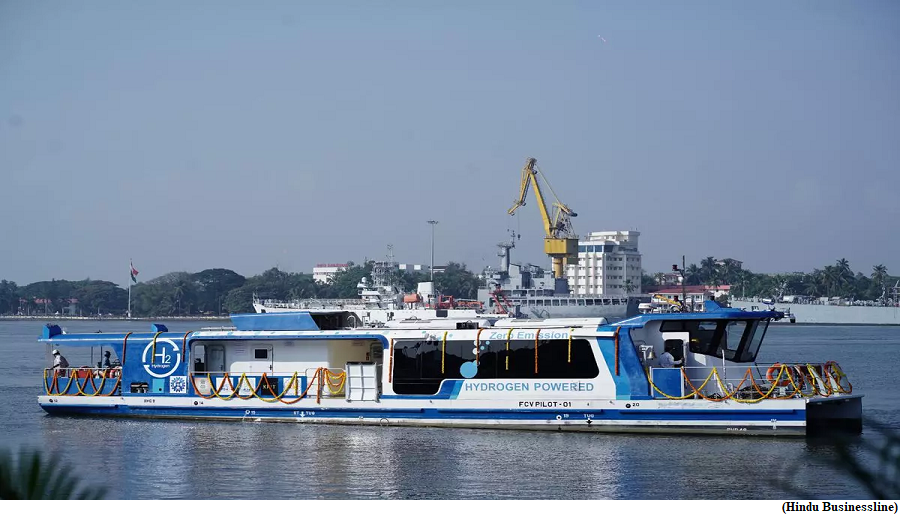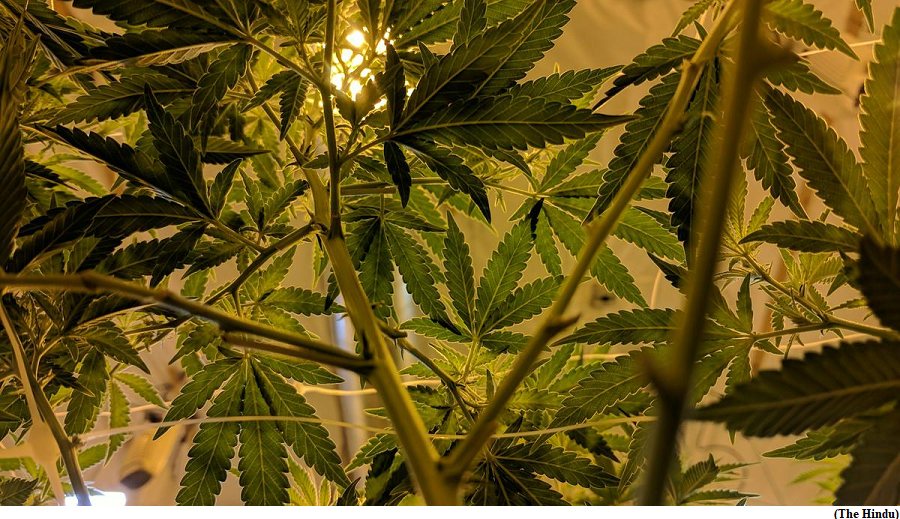PM Modi inaugurates country first indigenous hydrogen fuel cell ferry (GS Paper 3, Environment)

Why in news?
- Recently, the Prime Minister virtually launched India’s first indigenously developed hydrogen fuel cell ferry.
- The vessel, manufactured by Cochin Shipyard Limited (CSL), will be deployed for service at Varanasi in Uttar Pradesh.
Details:
- Built at a cost of Rs 18 crore, the ferry will be handed over to the Inland Waterways Authority of India by the CSL after rigorous trials.
- The Ministry of Ports, Shipping and Waterways met 75 per cent of the project cost.
What are the special features of the vessel?
- The Hydrogen fuel cell vessel is a 24-meter-long catamaran, which can carry 50 people in its air-conditioned passenger area. The accommodation area has been constructed with high-quality fiberglass reinforced plastic, similar to metro train coaches.
- Hydrogen fuel cell vessels do not use conventional batteries as the primary storage house of electrical energy.
- The vessels run on hydrogen fuel, which is stored in cylinders. This boat has five hydrogen cylinders that can carry 40kg of hydrogen and support eight hours of operations. The vessel is also fitted with a 3-kW solar panel.
- The hydrogen fuel cell-powered vessel has zero emission, zero noise and is energy-efficient, which makes it more environment-friendly. Since there are no moving parts, the ferry requires less maintenance than combustion vessels.
How do hydrogen fuel cells work?
- A hydrogen fuel cell generates electricity by utilising the chemical energy contained in hydrogen. It releases only pure water, not discharging pollutants. Hydrogen is loaded into cells.
- The energy within the hydrogen is converted into electricity and heat, which is then used to power the vessel’s propulsion mechanism.
- In the fuel cell, the hydrogen reacts with the oxygen in the air to produce electricity. Unlike batteries, hydrogen fuel cells do not require recharging. Provided uninterrupted supply of fuel and oxygen, these cells would work continuously.
What type of cells have been used in the vessel?
- This vessel uses a 50-kW PEM (proton-exchange membrane) fuel cell, with Lithium-Ion Phosphate batteries.
- The advantage is that the cells can quickly change their output depending upon the power demand. PEM fuel cells are popular in automotive applications because they operate at a lower temperature, and are lighter and more compact.
How was it developed?
- India has now indigenously developed hydrogen fuel cells and their related systems.
- The vessel has been built completely by the CSL, which also developed the vessel automation system and power management system.
- The hydrogen fuel cell system was developed by KPIT Technologies, Pune, in collaboration with the Council of Scientific and Industrial Research Labs, under the Union Ministry of Science and Technology.
- While hydrogen fuel cell technology has been under development for maritime applications, only a few countries globally have done demonstration projects. This ferry, thus, has given India an early mover advantage to tap the potential of hydrogen as an emerging green fuel in the marine sector.
- The ‘Harit Nauka’(green boat) initiative of the Ministry of Ports, Shipping and Waterways envisages a green transition of inland vessels. In line with this, the ferry can be replicated in other parts of the country for urban mobility. It is also a boost to the National Green Hydrogen Mission.
What is the Harit Nauka initiative?
- In January 2024, the shipping ministry unveiled the Harit Nauka guidelines for inland vessels.
- As per the guidelines, all states have to make efforts to use green fuels for 50 per cent of inland waterways-based passenger fleets in the next one decade, and 100 per cent by 2045. This is to reduce greenhouse gas emissions as per the Maritime Amrit Kaal Vision 2047.
Way Forward:
- Globally, the shipping industry is increasingly transitioning to green fuels due to environmental regulations, sustainability goals, and advancements in green fuel technologies.
- Hydrogen and its derivatives are gaining attention for promising zero-emission fuels for the industry.
The rocky vista of medicinal cannabis that research is bringing into view
(GS Paper 3, Science and Technology)
Why in news?
- Recently, researchers at the University of British Columbia in Canada floated a new clinical trial to examine whether cannabidiol could be used to treat bipolar depression.
- Given the paucity of agents to treat depressive episodes in bipolar disorder, this trial has the potential to uncover a novel treatment to treat the debilitating depression associated with the condition.

Major agents:
- The major psychotomimetic agent in C. sativa is a compound called delta-9-tetrahydrocannabinol (THC). There is growing interest in another cannabinoid, cannabidiol (CBD), which may have antipsychotic, anti-inflammatory, and neuroprotective properties.
- The plant’s flowering parts are more potent than its leaves. Marijuana is a combination of buds and leaves of pollinated female plants, and is usually cultivated outdoors.
Cannabinoid system:
- The human cannabinoid system has two cannabinoid receptors, called CB1 and CB2. The naturally occurring substrate of the CB1 receptor is anandamide, a compound whose name comes from the Sanskrit word ‘ananda’, meaning bliss.
- CB2 is found in the spleen and testes and to a lesser extent in the central nervous system (CNS). CB1 is found diffusely throughout the CNS.
- The CNS is involved in the release of various neurotransmitters, including dopamine, noradrenaline, and serotonin.
Endocannabinoid system:
- CB1 controls the levels and activities of other neurotransmitters. The CB1 receptor is relevant to the drug’s mind-altering effects. To stimulate these receptors, our bodies produce molecules called endocannabinoids.
- These are endogenous: they occur naturally within the body. The endocannabinoid system (ECS) comprises a dense network of chemical signals and cellular receptors. The cannabis plant works its effect by hijacking this machinery.
Role of THC:
- The cannabinoid system modulates a host of bodily functions, including pain, memory, psychomotor control, sleep, and appetite. THC in particular has acute effects on motor control and impairs fine movement. High doses of recreational cannabis use can disrupt short-term memory.
- Impaired attention is believed to be mediated by another part of the brain called the hippocampus, which is involved in memory and learning. This might indicate a possible role for THC in the extinction of bad memories in post-traumatic stress disorder (PTSD).
- The anti-nausea property of THC is useful to ameliorate nausea associated with chemotherapy. Cannabinoids are also used to treat acute and chronic pain syndromes.
- Nabilone, a synthetic cannabinoid, has been shown to ameliorate chronic neuropathic pain, headache, and fribromyalgic pain. Sativex, which contains both THC and CBD, has been used to manage pain associated with multiple sclerosis.
Bipolar disorder:
- There has been little scientific scrutiny of cannabis in relation to bipolar disorder, despite its widespread use by people with this condition.
- One 2009 study was able to conclude that people with bipolar disorder who used cannabis had more manic relapses, adhered less to medications, and had worse psychosocial outcomes compared to non-users. Research has also found that cannabis use can independently increase the risk of bipolar disorder and/or advance its onset in some individuals.
- Indeed, while cannabis can have psychotic effects on anybody upon consumption, the individual predisposition depends on their experience with the drug, the context in which it is consumed, and crucially, how prone the individual is to psychosis.
- People with established psychotic illnesses, such as schizophrenia, have a very high predisposition to manifest psychotic symptoms when imbibing cannabis, despite it being on anti-psychotic medication. Cannabis use in youth can also advance the onset of schizophrenia by seven to eight years in genetically vulnerable individuals.
Policy-making and legislation:
- C. sativa is also the most widely used illicit drug worldwide. The frequency and potency of cannabis use have also exploded in the last two decades, prompting broader debates about the decriminalisation of cannabis.
- This is partly because of the resurgence of interest in cannabis as medicine. Jurisdictions around the world are legalising medical use of cannabis; some have also legalised recreational use. Many of them are in the West but other countries are taking note as well.
- If India were to ever decriminalise cannabis, policymakers should ensure it isn’t commercialised and that there are protections against use by children, adolescents, and those with established mental illnesses, the populace most vulnerable to the detrimental effects of cannabis.



